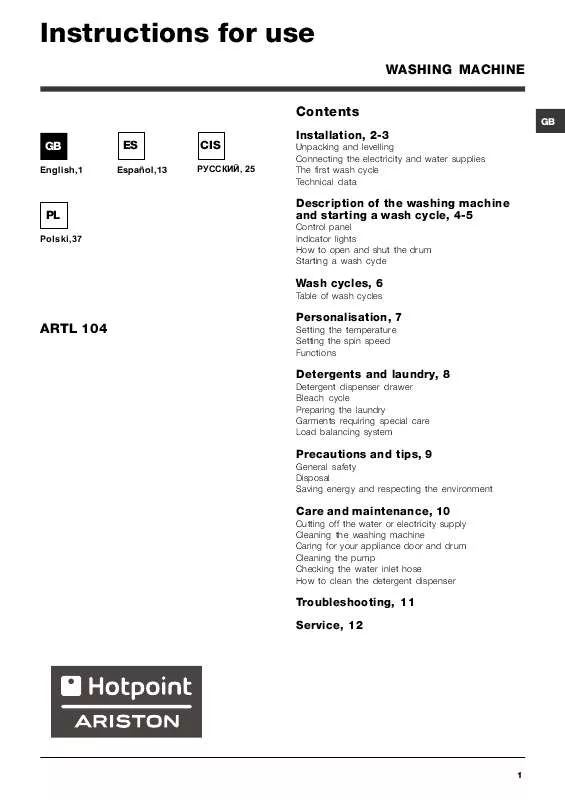Detailed instructions for use are in the User's Guide.
[. . . ] Instructions for use
WASHING MACHINE Contents
GB
English, 1
GB
ES
Español, 13
CIS
ÐÓÑÑÊÈÉ, 25
Installation, 2-3
Unpacking and levelling Connecting the electricity and water supplies The first wash cycle Technical data
PL
Polski, 37
Description of the washing machine and starting a wash cycle, 4-5
Control panel Indicator lights How to open and shut the drum Starting a wash cycle
Wash cycles, 6
Table of wash cycles
ARTL 104
Personalisation, 7
Setting the temperature Setting the spin speed Functions
Detergents and laundry, 8
Detergent dispenser drawer Bleach cycle Preparing the laundry Garments requiring special care Load balancing system
Precautions and tips, 9
General safety Disposal Saving energy and respecting the environment
Care and maintenance, 10
Cutting off the water or electricity supply Cleaning the washing machine Caring for your appliance door and drum Cleaning the pump Checking the water inlet hose How to clean the detergent dispenser
Troubleshooting, 11 Service, 12
1
Installation
GB
� Keep this instruction manual in a safe place for future reference. Should the appliance be sold, transferred or moved, make sure the instruction manual accompanies the washing machine to inform the new owner as to its operation and features. � Read these instructions carefully: they contain vital information on installation, use and safety. Levelling your appliance correctly will provide it with stability and avoid any vibrations, noise and shifting during operation. [. . . ] At the end of the cycle the washing machine will perform slow rotations of the drum. For the 4, 8, 11 wash cycle, the machine will end the cycle while the laundry is soaking, the EASY IRON and START/PAUSE indicator lights will flash (orange) and the RINSE phase will remain lit in a fixed manner. To drain the water so that the laundry may be removed, press the START/PAUSE button or the EASY IRON button. � This function may not be used in conjunction with wash cycles 5, 6, 7, 8, 9, 12,
,
,
. Extra rinse By selecting this function, the efficiency of the rinse is increased and optimal detergent removal is guaranteed. it is particularly useful for sensitive skin. � This function may not be used in conjunction with wash cycles 5, 6, , , . Super Wash Because a greater quantity of water is used in the initial phase of the cycle, and because of the increased cycle duration, this function offers a high-performance wash. � This function may not be used in conjunction with wash cycles 5, 6, 7, 11, 12, , , , . 7
Detergents and laundry
GB
Detergent dispenser drawer
Good washing results also depend on the correct dose of detergent: adding too much detergent won't necessarily make for a more efficient wash, and may in fact cause build up on the interior of your appliance and even pollute the environment. Open up the detergent dispenser and pour in the detergent and fabric softener, as follows. Preparing the laundry
Divide the laundry according to: - the type of fabric/the symbol on the label - the colours: separate coloured garments from whites. Empty all garment pockets and check the buttons. Do not exceed the listed values, which refer to the weight of the laundry when dry: Durable fabrics: max. 1 1 1 1 1 compartment 1: Detergent for pre-wash compartment 2: Detergent for the wash cycle (powder or liquid) It is recommended that you place liquid detergent directly into the compartment using the appropriate dosing cup. compartment 3: Additives (softener , etc. ) When pouring the softener in compartment 3, avoid exceeding the "max" level indicated. The softener is added automatically into the machine during the last wash. At the end of the wash programme, some water will be left in compartment 3. This is used for the inlet of denser fabric softeners into the machine, i. Should more than a normal amount of water remain in compartment 3, this means the emptying device is blocked. For cleaning instructions, see Care and maintenance. [. . . ] a delayed start has been set (see Personalisation). The water inlet hose is not connected to the tap. The START/PAUSE button has not been pressed. The washing machine does not take in water (the indicator light for the first wash cycle stage flashes rapidly). [. . . ]


